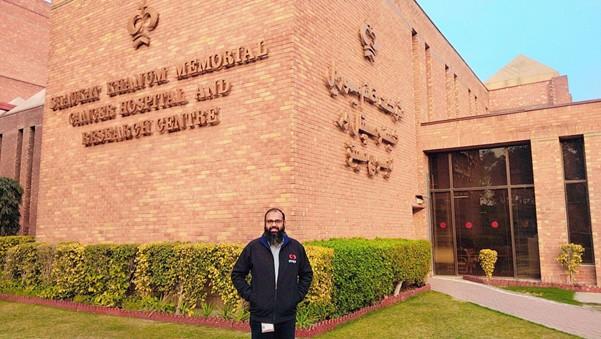By Ehsan Elahi, Pharm-D, M.Phil. Clinical Pharmacy Specialist – Oncology/Hematology/Blood & Marrow Transplant Assistant Manager Pharmacy | Preceptor ASHP-IPPRP & IAPPRP, Shaukat Khanum Memorial Cancer Hospital and Research Centre, Lahore, Pakistan

My day begins with a thorough review of patient charts—not only the prescribed medicines but also laboratory values, comorbidities, prior therapies, and any reported adverse effects. This preparation leads me to design and implement a pharmaceutical care plan for each patient, and equips me for the upcoming clinical ward rounds with oncologists, hematologists, nurses, and other members of the multidisciplinary team. During ward rounds, I engage in real-time discussions, offering consensus-building insights, whenever a patient’s treatment plan requires adjustment. These moments of collaboration are crucial.
Whether it is recommending a dose modification based on renal function, alerting the team to a drug–drug interaction, or proposing supportive care interventions, my contributions ensure therapy remains both effective and safe.
Cancer patients are uniquely vulnerable to medication errors, which makes chemotherapy appropriateness reviews an integral part of my responsibilities. Every prescribed protocol undergoes scrutiny—checking compatibility with the patient’s clinical status, appropriateness of dosing, and alignment with institutional and international guidelines and oncology stewardship principles. I am also involved in designing and implementing new chemotherapy protocols in computerized physician order entry within our Hospital Information System (HIS). The online chemotherapy protocols serve as templates and are readily available for any patient, where they serve as clinician’s prescriptions. This not only streamlines workflows for prescribers but also enhances safety by embedding standardized checks into the electronic prescribing process.
Beyond prescribing, I remain vigilant at the point of chemotherapy administration. Close collaboration with nursing teams ensures that chemotherapy is prepared, labeled, and delivered under sterile conditions.
Participation in daily surveillance audits safeguards patient safety and maintains compliance with sterile services protocols—because in oncology, even the smallest deviation can carry profound risks. As patients transition through their cancer journey, my role extends to discharge prescription review and reconciliation. This step prevents duplication, omission, or inappropriate continuation of medicines. Often, I address patient and caregiver concerns regarding chemotherapy regimens, supportive medications, and safe home use. By ensuring clarity and appropriateness, I help smoothen the continuum of care beyond hospital walls.
Patient safety also relies on ongoing monitoring of drug efficacy and toxicity. I routinely analyze charts, lab reports, and patient feedback to detect early signs of adverse drug reactions. These observations feed into our pharmacovigilance system, contributing to institutional learning and global reporting networks.
Interventions—whether dose reduction, drug substitution, or supportive therapy initiation—are implemented swiftly to preserve treatment outcomes.
A key part of my day involves multidisciplinary team meetings. Here, we chart out long-term treatment roadmaps, address emerging complications, and ensure alignment of pharmacotherapy with patient goals. Equally important is my role as a preceptor for pharmacy residents and trainees. Oncology is an ever-evolving field, and I actively contribute to training and educational activities, keeping teams updated on novel therapies, immunotherapies, biosimilars, and evolving guidelines. Sharing knowledge not only strengthens the profession but also inspires the next generation of oncology pharmacists.
Behind the scenes, I contribute to the often unseen but critical aspect of oncology care—medication supply chain management. I monitor drug inventory, forecast usage, and coordinate with the supply and clinical teams to preempt shortages. In oncology, where delays can directly impact survival outcomes, such proactive measures safeguard uninterrupted treatment access for patients.
Reflecting on my daily routine, I realize that my contributions—whether at the bedside, in protocol design, or behind the scenes—are all interwoven into a singular mission: to optimize cancer care. Every intervention, review, and collaboration is a step toward safer, more effective treatment for patients battling cancer. My journey as a clinical oncology pharmacist is fueled by passion, sustained by teamwork, and measured by patient outcomes. In every patient I serve, I see the reason why innovation, vigilance, and compassion must go hand in hand. It is this belief that continues to inspire me—and reaffirms why our role as oncology pharmacists is indispensable to advancing global cancer care.